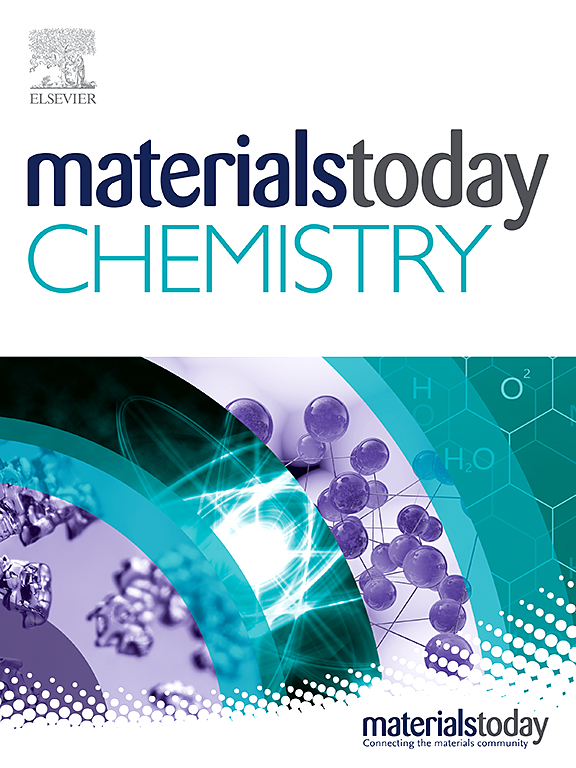Photoelectrochemical sensor for hypochlorous acid detection based on the MWNTs doped PEDOT loaded with BP5 functionalized gold nanoparticles
IF 6.7
2区 化学
Q1 CHEMISTRY, MULTIDISCIPLINARY
引用次数: 0
Abstract
Hypochlorous acid concentration anomaly may cause many serious diseases, so the development method to detect HClO high sensitivity and selectivity is of great significance in clinical diagnosis. Among many methods for detecting HClO, photoelectric chemical sensor has the advantages of high sensitivity and strong anti-interference ability, and has been widely used in the field of detecting HClO. Herein, a simple and specific photoelectrochemical sensor was constructed using A1/B1-type pillar[5]arene functionalized Au NPs and multi-walled carbon nanotube-polythiophene composites for the detection of hypochlorous acid. This approach was based on a sulfhydryl-borate ester modified A1/B1 type pillar[5]arene (BP5) as the main body, hypochlorous acid (HClO) as the guest, multi-walled carbon nanotube (MWNTs) conducting polymers doped with poly(3,4-ethylenedioxythiophene) (PEDOT) as the transport bridge and signal amplifier, as well as spherical gold nanoparticles act as the signal reporter. Specifically, the photoelectrochemical efficiency was further enhanced by the localized surface plasmon resonance effect (LSPR) of gold nanoparticles (Au NPs) and the host-guest complexation between BP5 and HClO. The large specific surface area of MWNTs doped with PEDOT significantly enhanced the electrical conductivity and chemical stability of PEDOT, facilitating accelerated electron transfer and mitigating the recombination of the photogenerated electron-hole pairs. Benefiting from the combination of Au NPs, BP5, MWNTs and PEDOT, the sensor exhibited excellent sensitivity with detection range of 0.5–340 μM and a detection limit of 0.17 μM, and distinguished selectivity against 6 interfering substances. Due to the adsorption and removal effects of pillar[5]arenes on heavy metal ions and pollutants in water, as well as their effective catalytic performance, we anticipate that this composite material also has great potential in photoelectrochemical detection, catalysis, and adsorption.基于掺杂了 BP5 功能化金纳米粒子的 MWNTs PEDOT 的次氯酸检测光电化学传感器
次氯酸浓度异常可能引发多种严重疾病,因此开发高灵敏度和高选择性的 HClO 检测方法在临床诊断中具有重要意义。在众多检测 HClO 的方法中,光电化学传感器具有灵敏度高、抗干扰能力强等优点,已被广泛应用于 HClO 的检测领域。本文利用 A1/B1 型柱[5]炔功能化金纳米粒子和多壁碳纳米管-聚噻吩复合材料构建了一种简单而特异的光电化学传感器,用于检测次氯酸。该方法以巯基硼酸酯修饰的 A1/B1 型柱[5]炔(BP5)为主体,次氯酸(HClO)为客体,掺杂聚(3,4-亚乙二氧基噻吩)(PEDOT)的多壁碳纳米管(MWNTs)导电聚合物为传输桥和信号放大器,球形金纳米粒子为信号报告器。具体而言,金纳米粒子(Au NPs)的局域表面等离子体共振效应(LSPR)以及 BP5 与 HClO 的主客体复合物进一步提高了光电化学效率。掺杂了 PEDOT 的 MWNTs 的大比表面积显著提高了 PEDOT 的导电性和化学稳定性,促进了电子的加速转移并减轻了光生电子-空穴对的重组。得益于 Au NPs、BP5、MWNTs 和 PEDOT 的结合,该传感器表现出优异的灵敏度(检测范围为 0.5-340 μM,检测限为 0.17 μM),并对 6 种干扰物质具有出色的选择性。由于柱[5]烷对水中重金属离子和污染物的吸附和去除作用,以及其有效的催化性能,我们预计这种复合材料在光电化学检测、催化和吸附方面也有很大的潜力。
本文章由计算机程序翻译,如有差异,请以英文原文为准。
求助全文
约1分钟内获得全文
求助全文
来源期刊

Materials Today Chemistry
Multiple-
CiteScore
8.90
自引率
6.80%
发文量
596
审稿时长
33 days
期刊介绍:
Materials Today Chemistry is a multi-disciplinary journal dedicated to all facets of materials chemistry.
This field represents one of the fastest-growing areas of science, involving the application of chemistry-based techniques to the study of materials. It encompasses materials synthesis and behavior, as well as the intricate relationships between material structure and properties at the atomic and molecular scale. Materials Today Chemistry serves as a high-impact platform for discussing research that propels the field forward through groundbreaking discoveries and innovative techniques.
 求助内容:
求助内容: 应助结果提醒方式:
应助结果提醒方式:


